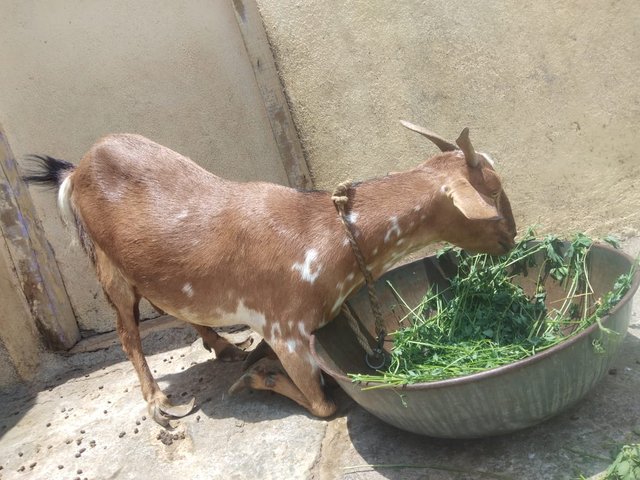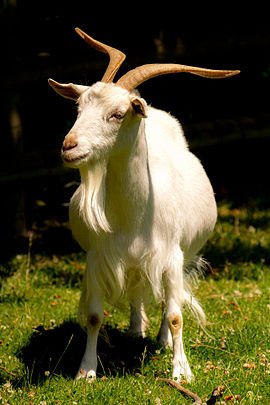
Hello everyone today I am going to tell you about my pet. Her name is billy actually I named her on the basis of her look and her breed name. let me tell all about her breed information..
Here we go...
For other species, see Capra (genus). For other uses, see Goat (disambiguation).
"Billy goat" redirects here. For other uses, see Billy goat (disambiguation).
The domestic goat or simply goat (Capra aegagrus hircus) is a subspecies of C. aegagrus domesticated from the wild goat of Southwest Asia and Eastern Europe. The goat is a member of the animal family Bovidae and the subfamily Caprinae, meaning it is closely related to the sheep. There are over 300 distinct breeds of goat.[1] It is one of the oldest domesticated species of animal, according to archaeological evidence that its earliest domestication occurred in Iran at 10,000 calibrated calendar years ago.[2]
Goat-herding is an ancient tradition that is still important in places like Egypt.
Goats have been used for milk, meat, fur, and skins across much of the world.[3] Milk from goats is often turned into goat cheese.
Female goats are referred to as does or nannies, intact males are called bucks or billies, and juvenile goats of both sexes are called kids. Castrated males are called wethers. While the words hircine and caprine both refer to anything having a goat-like quality, hircine is used most often to emphasize the distinct smell of domestic goats
History
Each recognized breed of goat has specific weight ranges, which vary from over 140 kg (300 lb) for bucks of larger breeds such as the Boer, to 20 to 27 kg (45 to 60 lb) for smaller goat does.[9] Within each breed, different strains or bloodlines may have different recognized sizes. At the bottom of the size range are miniature breeds such as the African Pygmy, which stand 41 to 58 cm (16 to 23 in) at the shoulder as adults.

Most goats naturally have two horns, of various shapes and sizes depending on the breed.[11] There have been incidents of polycerate goats (having as many as eight horns), although this is a genetic rarity thought to be inherited. Unlike cattle, goats have not been successfully bred to be reliably polled, as the genes determining sex and those determining horns are closely linked. Breeding together two genetically polled goats results in a high number of intersex individuals among the offspring, which are typically sterile.[11] Their horns are made of living bone surrounded by keratin and other proteins, and are used for defense, dominance, and territoriality.
As Pet
Goat breeders' clubs frequently hold shows, where goats are judged on traits relating to conformation, udder quality, evidence of high production, longevity, build and muscling (meat goats and pet goats) and fiber production and the fiber itself (fiber goats). People who show their goats usually keep registered stock and the offspring of award-winning animals command a higher price. Registered goats, in general, are usually higher-priced if for no other reason than that records have been kept proving their ancestry and the production and other data of their sires, dams, and other ancestors. A registered doe is usually less of a gamble than buying a doe at random (as at an auction or sale barn) because of these records and the reputation of the breeder. Children's clubs such as 4-H also allow goats to be shown. Children's shows often include a showmanship class, where the cleanliness and presentation of both the animal and the exhibitor as well as the handler's ability and skill in handling the goat are scored. In a showmanship class, conformation is irrelevant since this is not what is being judged.
Various "Dairy Goat Scorecards" (milking does) are systems used for judging shows in the US. The American Dairy Goat Association (ADGA) scorecard for an adult doe includes a point system of a hundred total with major categories that include general appearance, the dairy character of a doe (physical traits that aid and increase milk production), body capacity, and specifically for the mammary system. Young stock and bucks are judged by different scorecards which place more emphasis on the other three categories; general appearance, body capacity, and dairy character.
The American Goat Society (AGS) has a similar, but not identical scorecard that is used in their shows. The miniature dairy goats may be judged by either of the two scorecards. The "Angora Goat scorecard" used by the Colored Angora Goat Breeder's Association (CAGBA), which covers the white and the colored goats, includes evaluation of an animal's fleece color, density, uniformity, fineness, and general body confirmation. Disqualifications include: a deformed mouth, broken down pasterns, deformed feet, crooked legs, abnormalities of testicles, missing testicles, more than 3 inch split in scrotum, and close-set or distorted horns.